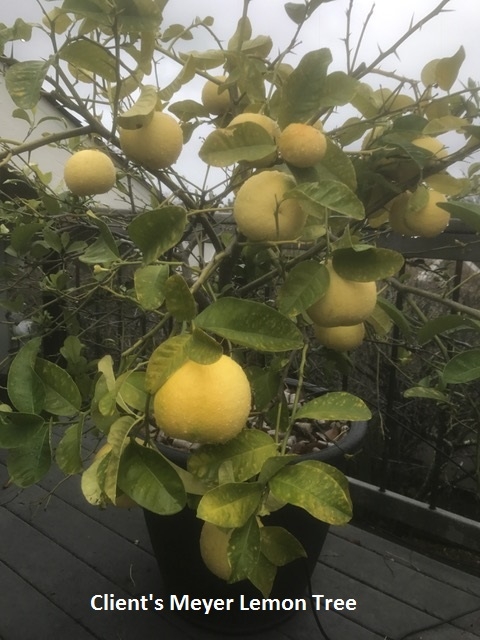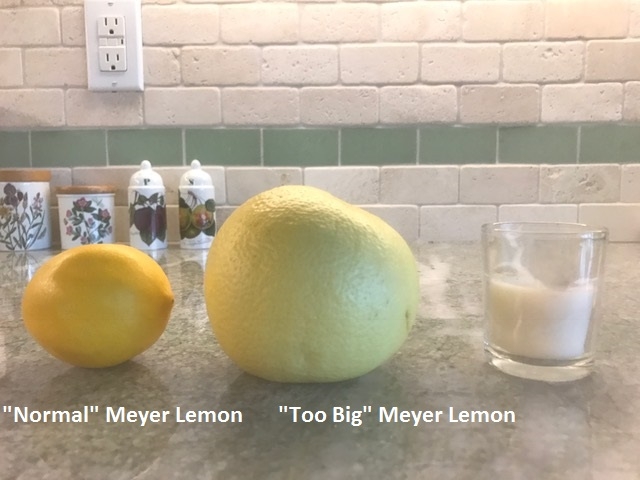Advice from the Help Desk of the
UC Master Gardener Program of Contra Costa County
Client's Request: What do you think caused my lemons to be too big (Picture 1). The second picture has a normal size Meyer lemon next to my too big Meyer lemon. All the lemons on the tree this year were like this. Last year most of the lemons were normal size except for three. The tree is about 8 to 10 years old. It's always been in the same pot on my deck. I fertilize it about three times a year. I appreciate any advice you can give me.

Response from the MGCC's Help Desk: Thank you for contacting the UC Master Gardener Program Help Desk with your question about your Meyer's lemon. It was a pleasure to talk to you in order to find out a bit more about your dwarf Meyer Lemon that has over-sized lemons with thick rinds and little juice.
After completing some research, reviewing the photograph of your 10 year old potted plant, and learning more about your fertilizing and irrigation routines, we have some information and suggestions to share with you that we hope you will find helpful.
Fruit Left on the Tree Too Long
Lemons may develop thick, puffy skin when left on the tree for too long after they ripen. You can wait to pick until the lemons have turned fully yellow, but to ensure juiciness and thinner skins, pick them while there is a little green still on the fruit.
Environmental Moisture and Watering
Dry weather or infrequent watering may cause your lemons to have a dry pulp. Water stress may prompt the tree to absorb moisture from the fruit's pulp, resulting in lemons with little juice. This reabsorption may also occur if you leave the lemons on the tree too long after they ripen. To prevent water stress, keep the top 5 to 6 inches of the soil moist; for dwarf lemons grown in a container, keep the top 1 to 2 inches of soil moist. Alternatively, excessive moisture in the air from high humidity levels may cause puffy rinds with a coarser texture and duller color, though the amount of juice may not be affected.
It's Time to Repot your Meyer Lemon
It is probably time to repot your Meyer Lemon. Potted lemon trees require repotting every two to three years, or when the roots begin growing out the drainage holes. The best time to repot your tree is in spring during heavy growth so it has time to establish in the new container.
Select a container one size larger than the current container. For example, upgrade from a 5 gallon to a 7-gallon pot or a 7-gallon to a 15-gallon pot.
Fill the new pot one-fourth full with a potting soil similar to the type used in the old container. Water the soil until it's evenly moist and the excess just begins to drain from the bottom.
Insert a trowel or knife between the soil and pot sides to loosen the root ball from the container. Grasp the tree near its base and lift it up while a second person pulls the pot downward.
Thoroughly examine the roots and locate any roots that are completely encircling the root ball. Slice through these roots with a clean knife; otherwise, they may constrict the root ball as they grow and cause the tree to die. Remove any dead root material.
Set the tree in the new pot. Adjust the depth of the soil beneath the root ball so the top of the root system sits 2 inches beneath the pot rim. The top of the roots should be just beneath the soil surface, and crown roots (root collar area) should show above the soil line.
Fill in around the roots with additional soil until the lemon tree is potted at the same depth it was at previously. Water thoroughly so the soil settles around the roots and add more soil, if necessary.
Possibly Over Fertilizing Your Tree
Most mature citrus require regular fertilization with nitrogen. Your fertilizer should have more nitrogen (N) than phosphorous (P) or potassium (K). Use at least a 2-1-1 ratio. Typically, most other nutrients are available in sufficient amounts in the soil. Nitrogen should be applied in January or February just prior to bloom. The second application then can be applied in May and perhaps a third in June. Avoid late-season fertilization as it may affect fruit quality, delay fruit coloring, and make the rind tough. Dwarf plants or trees in containers with restricted root space may require less fertilizer. Be careful not to over-fertilize as this could cause excessive new growth, which makes trees susceptible to other disorders.
Here is a list of citrus care articles that you may find helpful for the continuing health of your tree:
http://homeorchard.ucanr.edu/Fruits_&_Nuts/Citrus/
http://ipm.ucanr.edu/PMG/GARDEN/FRUIT/citrus.html
//ucanr.edu/blogs/slomggarden/blogfiles/4260.pdf
We certainly hope this information is helpful to you. Please do not hesitate to contact us again should you have any other questions about your lemon tree or other horticultural needs.
Help Desk of the Master Gardener Program of Contra Costa County (WHM /SLH)
Note: The UC Master Gardeners Program of Contra Costa's Help Desk is available year-round to answer your gardening questions. Except for a few holidays, we're open every week, Monday through Thursday for walk-ins from 9:00 am to Noon at 75 Santa Barbara Road, 2d Floor, Pleasant Hill, CA 94523. We can also be reached via telephone: (925) 646-6586, email: ccmg@ucanr.edu, or on the web at http://ccmg.ucanr.edu/Ask_Us/ MGCC Blogs can be found at http://ccmg.ucanr.edu/HortCoCo/ You can also subscribe to the Blog (//ucanr.edu/blogs/CCMGBlog/).